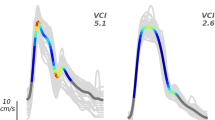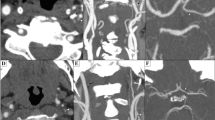Abstract
We evaluated the optimal flow velocity of transcranial doppler (TCD) in detecting unilateral middle cerebral artery (MCA) stenosis and stenosis grading by magnetic resonance angiography (MRA) as the reference standard. 302 nonconsecutive patients with unilateral MCA stenosis detected by TCD underwent MRA of the intracranial arteries. The peak systolic velocity (PSV), mean flow velocity (MFV), and end-diastolic velocity (EDV) of each MCA were recorded. 604 MCA were categorized into four groups depending on the stenosis severity: normal MCA (n = 319, 52.8 %), mild stenosis (n = 94, 15.6 %), moderate stenosis (n = 66, 10.9 %), and severe stenosis (n = 125, 20.7 %). Significant differences in PSV, MFV, and EDV between these four groups were observed (P < 0.001, respectively). The optimal cutoff velocities for detecting MCA stenosis were: PSV = 160 cm/s, MFV = 100 cm/s, EDV = 60 cm/s; the optimal cutoff points to distinguish mild from moderate stenosis were: PSV = 200 cm/s, MFV = 120 cm/s, EDV = 80 cm/s; the cutoffs to distinguish moderate from severe stenosis were: PSV = 280 cm/s, MFV = 180 cm/s, EDV = 110 cm/s. Using PSV as the diagnostic criteria, the correlation for diagnosing MCA stenosis using TCD and MCA was good (Kappa number κ = 0.668); using as MFV criteria, κ = 0.641. The optimal cutoff PSV values in stenosis grading on TCD were 160, 200, and 280 cm/s. The optimal cutoff MFV values were 100, 120, and 180 cm/s. PSV is more accurate than MFV in detecting and grading MCA stenosis.




Similar content being viewed by others
References
Nishimaru, K., McHenry, L. C., & Toole, J. F. (1984). Cerebral angiographic and clinical differences in carotid system transient ischemic attacks between American Caucasian and Japanese patients. Stroke, 15, 56–59.
Feldmann, E., Daneault, N., Kwan, E., et al. (1990). Chinese-white differences in the distribution of occlusive cerebrovascular disease. Neurology, 40, 1541–1545.
Wityk, R. J., Lehman, D., Klag, M., et al. (1996). Race and sex differences in the distribution of cerebral atherosclerosis. Stroke, 27, 1974–1980.
Huang, Y. N., Gao, S., Li, S. W., et al. (1997). Vascular lesions in Chinese patients with transient ischemic attacks. Neurology, 48, 524–525.
Mazighi, M., Tanasescu, R., Ducrocq, X., et al. (2006). Prospective study of symptomatic atherothrombotic intracranial stenoses: the GESICA study. Neurology, 66, 1187–1191.
Samuels, O. B., Joseph, G. J., Lynn, M. J., et al. (2000). A standardized method for measuring intracranial arterial stenosis. American Journal of Neuroradiology, 21, 643–646.
Rorick, M. B., Nichols, F. T., & Adams, R. J. (1994). Transcranial Doppler correlation with angiography in detection of intracranial stenosis. Stroke, 25, 1931–1934.
Arenillas, J. F., Molina, C. A., Montaner, J., et al. (2001). Progression and clinical recurrence of symptomatic middle cerebral artery stenosis: a long-term follow-up transcranial Doppler ultrasound study. Stroke, 32, 2898–2904.
Felberg, R. A., Christou, I., Demchuk, A. M., et al. (2002). Screening for intracranial stenosis with transcranial Doppler: the accuracy of mean flow velocity thresholds. Journal of Neuroimaging, 12, 9–14.
Feldmann, E., Wilterdink, J. L., Kosinski, A., et al. (2007). The Stroke Outcomes and Neuroimaging of Intracranial Atherosclerosis (SONIA) trial. Neurology, 68, 2099–2106.
Gao, S., Lam, W. W., Chan, Y. L., et al. (2002). Optimal values of flow velocity on transcranial Doppler in grading middle cerebral artery stenosis in comparison with magnetic resonance angiography. Journal of Neuroimaging, 12, 213–218.
Hao, Q., Gao, S., Leung, T. W., et al. (2010). Pilot study of new diagnostic criteria for middle cerebral artery stenosis by transcranial Doppler. Journal of Neuroimaging, 20, 122–129.
de Bray, J. M., Joseph, P. A., Jeanvoine, H., et al. (1988). Transcranial Doppler evaluation of middle cerebral artery stenosis. Journal of Ultrasound in Medicine, 7, 611–616.
Suwanwela, N. C., Phanthumchinda, K., & Suwanwela, N. (2002). Transcranial doppler sonography and CT angiography in patients with atherothrombotic middle cerebral artery stroke. AJNR. American Journal of Neuroradiology, 23, 1352–1355.
Alexandrov, A. V. (2007). The Spencer’s curve: Clinical implications of a classic hemodynamic model. Journal of Neuroimaging, 17, 6–10.
Stock, K. W., Radue, E. W., Jacob, A. L., et al. (1995). Intracranial arteries: Prospective blinded comparative study of MR angiography and DSA in 50 patients. Radiology, 195, 451–456.
Spencer, M. P., & Reid, J. M. (1979). Quantitation of carotid stenosis with continuous-wave (C-W) Doppler ultrasound. Stroke, 10, 326–330.
Gao S, Huang JX. (2004) The diagnostic technology and clinical application of transcranial doppler: Chinese Peking Union Medical College Press. 54.
Demirkaya, S., Uluc, K., Bek, S., et al. (2008). Normal blood flow velocities of basal cerebral arteries decrease with advancing age: A transcranial Doppler sonography study. Tohoku Journal of Experimental Medicine, 214, 145–149.
Xing, Y. Q., Han, K., Bai, Z., et al. (2008). The diagnostic value of transcranial Doppler sonography of hemodynamic changes of intracranial circulation in the patients with chronic middle cerebral artery occlusion. Chinese Journal of Gerontology, 28, 1906–1909.
Author information
Authors and Affiliations
Corresponding author
Additional information
Jiafeng Chen, Lin Wang and Jing Bai contributed equally to the manuscript.
Rights and permissions
About this article
Cite this article
Chen, J., Wang, L., Bai, J. et al. The Optimal Velocity Criterion in the Diagnosis of Unilateral Middle Cerebral Artery Stenosis by Transcranial Doppler. Cell Biochem Biophys 69, 81–87 (2014). https://doi.org/10.1007/s12013-013-9771-9
Published:
Issue Date:
DOI: https://doi.org/10.1007/s12013-013-9771-9




